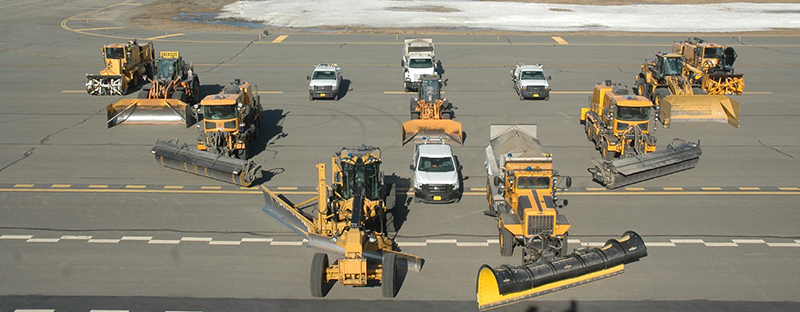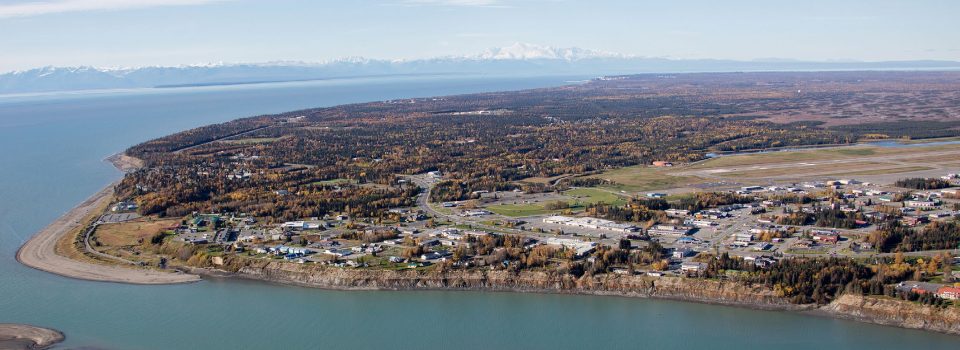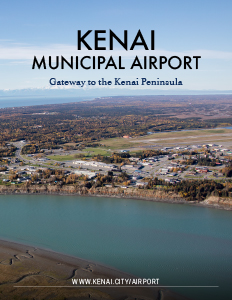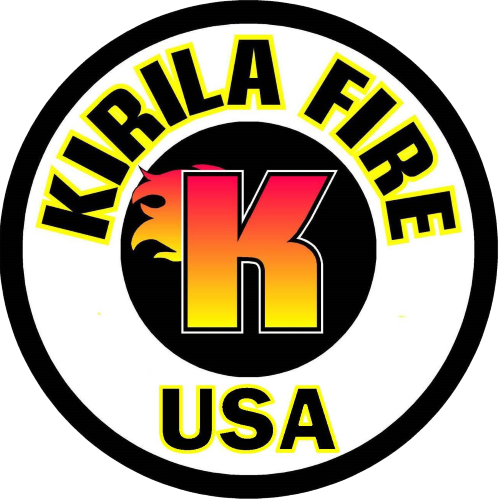Kenai Municipal Airport
Gateway to the Kenai Peninsula
Business View Magazine interviews Mary Bondurant, Airport Manager at Kenai Municipal Airport, as part of our series on regional American airports.
Kenai Municipal Airport is a city-owned, commercial and general aviation airport located in Kenai, a city in the Kenai Peninsula Borough of Alaska. The airfield covers an area of 1,200 acres at an elevation of 99 feet above mean sea level, and has two runways: 2L/20R with a 7,855 X 150 feet grooved asphalt pavement; and 2R/20L with a 1,980 X 75 feet gravel surface. The Airport also has a float plane basin area designated 2W/20W which measures 4,600 X 252 feet. Tie-downs are available for wheeled, float, and ski aircraft. In addition, there are two asphalt helipads that are 100 X 100 feet on the north and south ends of the apron.
The Kenai Airport has a precision instrument approach on Runway 20R and a non- precision instrument approach on Runway 02L. Credit card fuel pumps are available 24-hours a day for both wheeled and float aircraft in addition to aircraft maintenance and avionics sales and service offered by Peninsula Aero Technology. The Airport has an Air Traffic control tower, an Aircraft Rescue and Fire Fighting (ARFF) station, and a 24/7 Automated Flight Service Station. United Parcel Service, Federal Express, and Everts Air Fuel provide transit for nearly any size or variety of materials. Guardian Flight is on-field for medical responses and the State of Alaska Division of Forestry operates a retardant base on-field for wildland fires. The runway and apron can accommodate commercial aircraft up to 757’s and is used as an alternate airport for many of the major carriers serving Alaska. The Airport is also used as an alternate for the F22’s stationed at Joint Base Elmendorf–Richardson facility in Anchorage.
 The Kenai Municipal Airport started out as a small military strip. In 1963, the airfield was part of a 2,000-acre transfer of land from the FAA to the City of Kenai. Since that time, its primary mission has been to be the commercial air transportation gateway to the Kenai Peninsula Borough and West Cook Inlet. During the late 1970s and early 1980s, the Airport had scheduled passenger jet service to Seattle and Anchorage via Wien Air Alaska, one of the oldest airlines in the U.S. and the first in the state. In 1984, Seattle service ended and Wien was only flying nonstop service to Anchorage with all flights operated with commuter turboprop aircraft.
The Kenai Municipal Airport started out as a small military strip. In 1963, the airfield was part of a 2,000-acre transfer of land from the FAA to the City of Kenai. Since that time, its primary mission has been to be the commercial air transportation gateway to the Kenai Peninsula Borough and West Cook Inlet. During the late 1970s and early 1980s, the Airport had scheduled passenger jet service to Seattle and Anchorage via Wien Air Alaska, one of the oldest airlines in the U.S. and the first in the state. In 1984, Seattle service ended and Wien was only flying nonstop service to Anchorage with all flights operated with commuter turboprop aircraft.
Today, Kenai is serviced by Grant Aviation, a Part 135 operator with flights to Anchorage. Up until recently, it was also serviced by Corvus Air, a Part 121 operator, owned by the RavnAir Group. The parent company declared bankruptcy this past April, a financial victim of the COVID-19 pandemic. It cancelled all of its Alaska operations at more than 100 Alaskan communities, parked all 72 of its planes, and laid off 1,300 employees. Grant Aviation, upped its flights to increase capacity for people trying to make the route, which is an approximately 20-minute flight compared to a three-hour drive. Kenai Aviation also offers air taxi and charter service.
Mary Bondurant is Kenai’s Airport Manager. She operates the airfield with one administrative assistant and a three-person operations staff, which can increase to five during the winter with temporary call-outs, when the weather is particularly bad. “We’re renowned for our snow and ice control in the winter time,” she exclaims.
Bondurant hopes that before the next winter comes, regularly scheduled Part 121 air service will return to Kenai, which is, at least a possibility, currently. This past July, at RavnAir’s bankruptcy hearing, Float Shuttle, a southern California commuter flight service, bought six of Ravn’s Dash-8 planes and Corvus’s Part 121 federal operating certificate, with the intent of re-instating scheduled, regional service by in September.
Should that come to pass, Bondurant wants to be ready. Current Airport improvement projects are the purchase of a new piece of snow removal equipment and construction of a sand/SRE equipment storage building. “We hope to get this sand storage building kicked off this fall,” she says. “We’ll be able to store a winter’s worth of sand – that’s 1,200 to 1,500 yards of heated sand – which will give us more dedicated time for snow and ice control.”
 “Last year, we secured a grant of approximately $6 million to upgrade our Alaska Fire Training Facility, she adds. “It included an upgrade to the building and also the Aircraft Rescue and Firefighting (ARFF) training equipment. That had not been upgraded since 1998, and parts were becoming hard to find. Two new ARFF fire trucks were ordered and will be here next year.” The Center will provide state-of-the-art props that will provide the skills and training requirements to perform aircraft rescue firefighting duties for airports of all indexes.
“Last year, we secured a grant of approximately $6 million to upgrade our Alaska Fire Training Facility, she adds. “It included an upgrade to the building and also the Aircraft Rescue and Firefighting (ARFF) training equipment. That had not been upgraded since 1998, and parts were becoming hard to find. Two new ARFF fire trucks were ordered and will be here next year.” The Center will provide state-of-the-art props that will provide the skills and training requirements to perform aircraft rescue firefighting duties for airports of all indexes.
Looking ahead, Bondurant references the Airport’s 2017 Master Plan, which developed a three-phase Capital Improvement Program that goes through 2030. “We have a lot of projects that we identified during the process,” she explains. “We could potentially be doing a total runway rehab project in about four years; the last time we did it was in 2007. We have a beautiful float plane facility; we’d like to get a taxiway from the main grooved runway over to the water runway, so we can get some leased lots in there and open up that float plane basin.”
But, undoubtedly, the Airport’s terminal project has been its overriding priority for the last two years. “It was originally built in 1966,” Bondurant explains, “with a couple of re-models in the ‘80s; flooring and carpet in 2001. So, a very much-needed project kicked off in October 2018. We met with our tenants and stakeholders, and looked at what our needs were. A lot of it you don’t see—mechanical, electrical. We’re in the final stages of closing it out.” The terminal serves over 100,000 enplanements each year.
The $12.5 million price tag was paid for mostly by the FAA, with the City of Kenai kicking in $1.5 million. The only material change to the footprint of the terminal was moving the east wall out about seven feet, which gave the airlines more space for baggage processing. The building got a new roof, siding and flooring, and additional windows. Business tenants, like the rental car agencies have new offices, and there is additional space for more tenants. The restaurant space, which is currently occupied by Brothers Café, and the lounge, operated by the Upper Deck, also got updates.
When the north section of the terminal near the ticket desks was renovated, the longtime, public lands display had to come out. The public land agencies in the peninsula area, headed up by the Kenai National Wildlife Refuge, teamed up to refresh it, and the result is a floor-to-ceiling set of informational panels with dozens of images that highlight the Refuge, as well as Katmai National Park, Lake Clark National Park, and the Kenai Fjords National Park. In the center is a huge map extending away from Kenai to Lake Iliamna, Lake Clark, and down to the Outer Coast. In the past, people have largely come to Kenai for one thing: fishing. But with fish runs down and questions about capacity, the display suggests a wide variety of other activities, from bear viewing, to kayaking, to staying in public use cabins.
In 2018, the City revised its land leasing program to encourage growth and development of lands by simplifying and streamlining processes and offering development incentives and favorable lease conditions to make the Kenai Municipal Airport and surrounding properties the best leasing environment of all airports on the Kenai Peninsula. Kenai is the heart of activity on the Kenai Peninsula with industries that include oil, natural gas, commercial fishing, tourism, and aviation. Multiple lots are available for retail, service, office, space, warehouse, and production, marine-related services in addition to lots available for general aviation, air taxi, air cargo aircraft parking, hangars, fueling, and aviation support providers. Convenient, safe, and reliable the Kenai Municipal Airport is a flexible, expanding, modern enterprise ready to meet the public’s business or travel needs.
AT A GLANCE
WHO: Kenai Municipal Airport
WHAT: A city-owned, commercial and general aviation airport
WHERE: Kenai, Alaska
WEBSITE: www.kenai.city/airport
PREFERRED VENDORS
Kirila Fire Training Facilities, Inc. – www.kirilafire.com
The skilled workforce at Kirila Fire specializes in the design, manufacturing, construction, erection, and maintenance of customized fire training structures and facilities. Kirila Fire is familiar with national and international standards associated with fire training systems and the procedures for performing various fire training scenarios.
The company is owned and operated by Jerry Kirila, who has been in the fire training industry for over 20 years, with a global presence in 18 countries, and is one of the world’s most creative, dependable, and sought-after design/build fire training facility manufactures.
Kirila Fire’s 45,000-sq.-ft. headquarters and manufacturing facility is located in Fowler, Ohio. The facility is fully equipped with modern fabrication equipment and tooling. The workforce consists of an engineering staff, CAD design teams, project managers, fabricators, electricians, pipefitters, and controls specialist to support Kirila Fire as an OEM of fire training equipment proudly made in the USA. In addition, Kirila Fire maintains several Mobile Workshop Rigs (MWRs) and field crews to support on-site fire training facilities installation and to provide ongoing service maintenance for fire training systems. These teams travel to the end user’s site with truck and trailer rigs that are fully stocked with the necessary equipment, parts, and tools to service these types of facilities.
The company features a maintenance staff devoted exclusively to fire trainer service work and is experienced in all aspects of mechanical, electrical, civil, and structural work. Kirila Fire also has the knowledge and experience to maintain and service fire training equipment provided by all other major manufacturers. Currently, Kirila Fire maintains over 200 fire trainers globally.
To date, Kirila Fire has completed over a thousand live–fire related training simulator projects, including service and repairs, including the United States military, civil aviation, municipalities, training schools, and other international markets.




